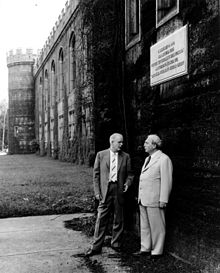
Amos Alonzo Stagg Field is the name of two successive football fields for the University of Chicago. Beyond sports, the first Stagg Field (1893–1957), named for famed coach, Alonzo Stagg, is remembered for its role in a landmark scientific achievement of Enrico Fermi and the Metallurgical Laboratory during the Manhattan Project. The site of the first artificial nuclear chain reaction, which occurred within the field's west viewing-stands structure, received designation as a National Historic Landmark on February 18, 1965.[1] On October 15, 1966, which is the day that the National Historic Preservation Act of 1966 was enacted creating the National Register of Historic Places, it was added to that as well.[2] The site was named a Chicago Landmark on October 27, 1971.[3]
A Henry Moore sculpture, Nuclear Energy, in a small quadrangle commemorates the location of the nuclear experiment.[1] The University's current Stagg Field a football, soccer, and track field is located a few blocks away and reuses one of the original gates.
- ^ a b Site of First Self-Sustaining Nuclear Reaction Archived 2015-04-05 at the Wayback Machine, NHL Database, National Historic Landmarks Program. Retrieved 11 February 2007.
- ^ "National Register Information System". National Register of Historic Places. National Park Service. July 9, 2010.
- ^ "Site of the First Self-Sustaining Controlled Nuclear Chain Reaction". City of Chicago Department of Planning and Development, Landmarks Division. 2003. Retrieved March 31, 2007.
